Category Archives for Garmin
GFC 500/GFC 600 Autopilot Approvals Expanded
We are pleased to announce our GFC 500 autopilot will soon receive Federal Aviation Administration (FAA) Supplemental Type Certification (STC) in the Cessna 182RG. Additionally, FAA STC approval is imminent for the GFC 600 autopilot in the Piper PA-46 310P/350P JetPROP and Socata TBM 700/850. When properly equipped, the GFC 600 also offers new features in the TBM 700/850, including Emergency Decent Mode (EDM) and Low Bank Mode.
New
autopilot approvals
The
GFC 500 and GFC 600 deliver superior in-flight characteristics, self-monitoring
capabilities and minimal maintenance needs when compared to older generation
autopilot systems. The GFC 500 is intended for single-engine piston aircraft,
while the GFC 600 is intended for high performance piston single/twin-engine
and turbine aircraft that have a wide range of speed and performance
characteristics.

Aircraft
models to soon be approved for the GFC 500 autopilot include:
- Cessna
182RG- Models:
R182, FR182, TR182
- Models:
Aircraft
models to soon be approved for the GFC 600 autopilot include:
- Piper
PA-46- Models:
310P JetPROP, 350P JetPROP
- Models:
- Socata
TBM- Models:
700, A, B, C1, C2, N (TBM 850)
- Models:

New
GFC 600 Features
With
the approval of the GFC 600 autopilot in the TBM 700/850, new features will be
introduced to GFC 600. Low Bank mode helps increase passenger comfort by
automatically lowering the autopilot roll limit at higher altitudes. A separate
switch may also be used by the pilot to activate/deactivate Low Bank Mode at
any altitude. Additionally, GFC 600-equipped TBM 700/850 aircraft will also
feature Emergency Descent Mode (EDM). In the event an aircraft loses cabin
pressurization, EDM is capable of automatically descending the aircraft to a
preset altitude without pilot intervention to help avert hypoxic situations. In
addition to the GFC 600 autopilot, a G600 TXi flight display is also required
to receive these new autopilot features in the TBM 700/850.
The GFC 500 autopilot will soon be available for the Cessna 182RG in August. The GFC 600 autopilot in the TBM 700/850 and PA-46 310P/350P JetPROP is also expected to be available in August. We continue to broaden the aircraft approval list for the GFC 600 and GFC 500 autopilots. To view the most up-to-date aircraft STC list, or to view a list of certification programs that are expected to begin in the next 12-months, visit www.garmin.com/GFC500 or www.garmin.com/GFC600. For additional information, visit www.garmin.com/aviation.
The post GFC 500/GFC 600 Autopilot Approvals Expanded appeared first on Garmin Blog.
https://www.garmin.com/en-US/blog/aviation/gfc-500-gfc-600-autopilot-approvals-expanded/
TeamX Brings New Features to G5 Electronic Flight Instrument and G3X Touch Flight Display
Our avionics engineering group for experimental aircraft— TeamX — has introduced new features and enhancements to the G5 electronic flight instrument for certified and experimental aircraft including the display of outside air temperature (OAT), true airspeed (TAS), winds and more. They have also introduced wireless engine data streaming, flight data logging and new display configurations are also new to the G3X Touch flight display for experimental aircraft.
“TeamX, our dedicated team of passionate pilots and experimental aircraft builders, continue to roll out
additional updates that add more capability to aircraft with a new or existing G5 electronic flight
instrument or G3X Touch flight display,” said Carl Wolf, Garmin vice president of aviation sales and
marketing. “Garmin remains committed to offering value-minded solutions that give pilots even more
features and flexibility when considering an avionics installation, and we are thrilled to give thousands of
customers more reasons to pursue a flight display upgrade.”
G5 electronic flight instrument for certified and experimental aircraft
The G5 electronic flight instrument will soon be capable of displaying outside air temperature (OAT) and
true airspeed (TAS) using a temperature probe and Garmin adapter. Similar to other Garmin products,
OAT is displayed along the bottom of the airspeed indicator on the G5, while TAS is displayed on the top.
When G5 is configured as a directional gyro (DG) or horizontal situation indicator (HSI), wind speed and
direction is also displayed in the upper left corner of the G5. For standalone G5 installations, additional
hardware is required to display OAT and TAS. New for experimental aircraft, G5 can also display density
altitude below the altimeter while the aircraft is on the ground.
The G5 electronic flight instrument for certified aircraft can soon be paired with dual digital Garmin navigation sources, such as a GTN 650/750 or GPS 175/GNC 355/GNX 375, and manually switch between the sources on the G5. For VFR installations, pilots can also use a Garmin portable to display lateral course deviation information on the G5.
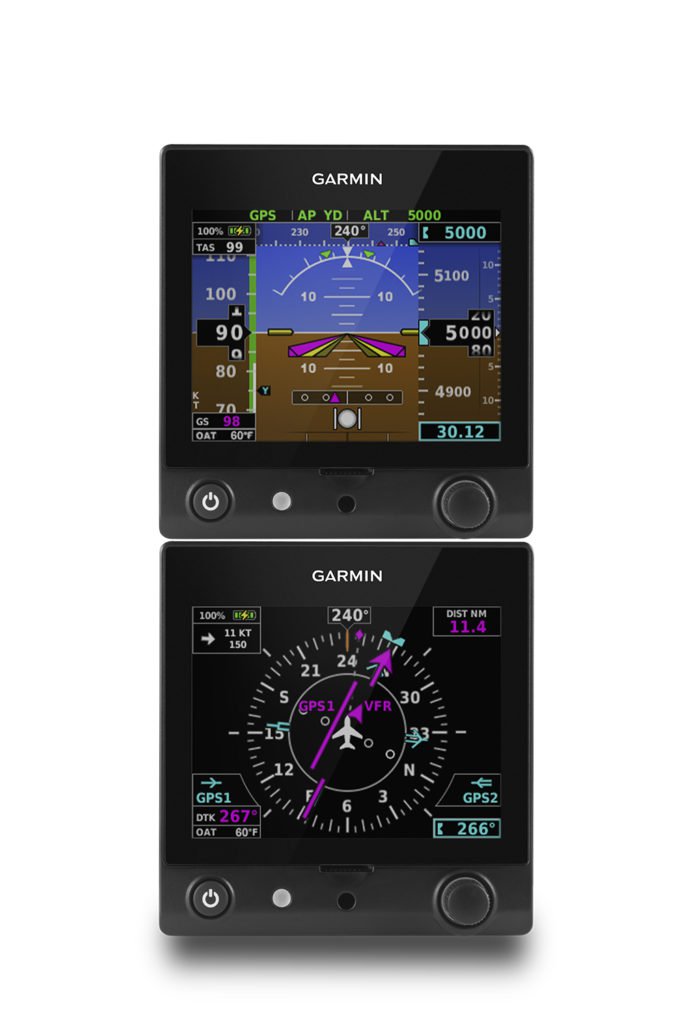
G3X Touch for experimental aircraft
Pilots are provided with a comprehensive, in-depth look at engine performance and trend data with G3X Touch for experimental aircraft, which includes built-in engine and flight data logging. Aircraft performance, engine data and any exceedances that may occur are automatically stored on an SD card in the display. In addition to data logging, pilots can view real-time detailed engine information from
G3X Touch within the Garmin Pilot app. This information is sent wirelessly from G3X Touch to Garmin Pilot. Pilot-configurable exceedances can also be set within the Garmin Pilot app.
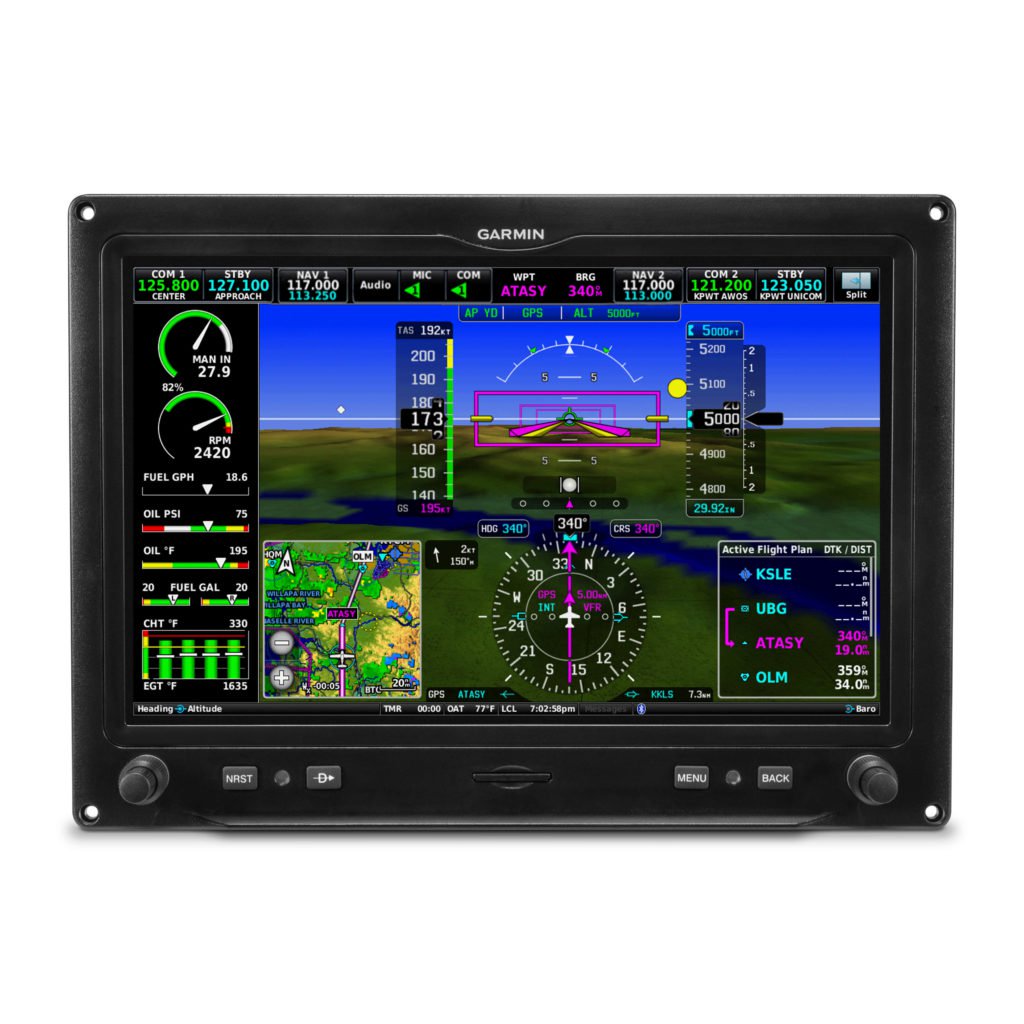
G3X Touch for experimental aircraft is also adding a new display configuration – a standalone
Multifunction Display (MFD) with an optional Engine Indication System (EIS). This display configuration is
a natural addition to thousands of aircraft with a single or dual G5 installation. The G3X Touch is also
capable of displaying maps, charts, weather, traffic, terrain and more, alongside engine information.
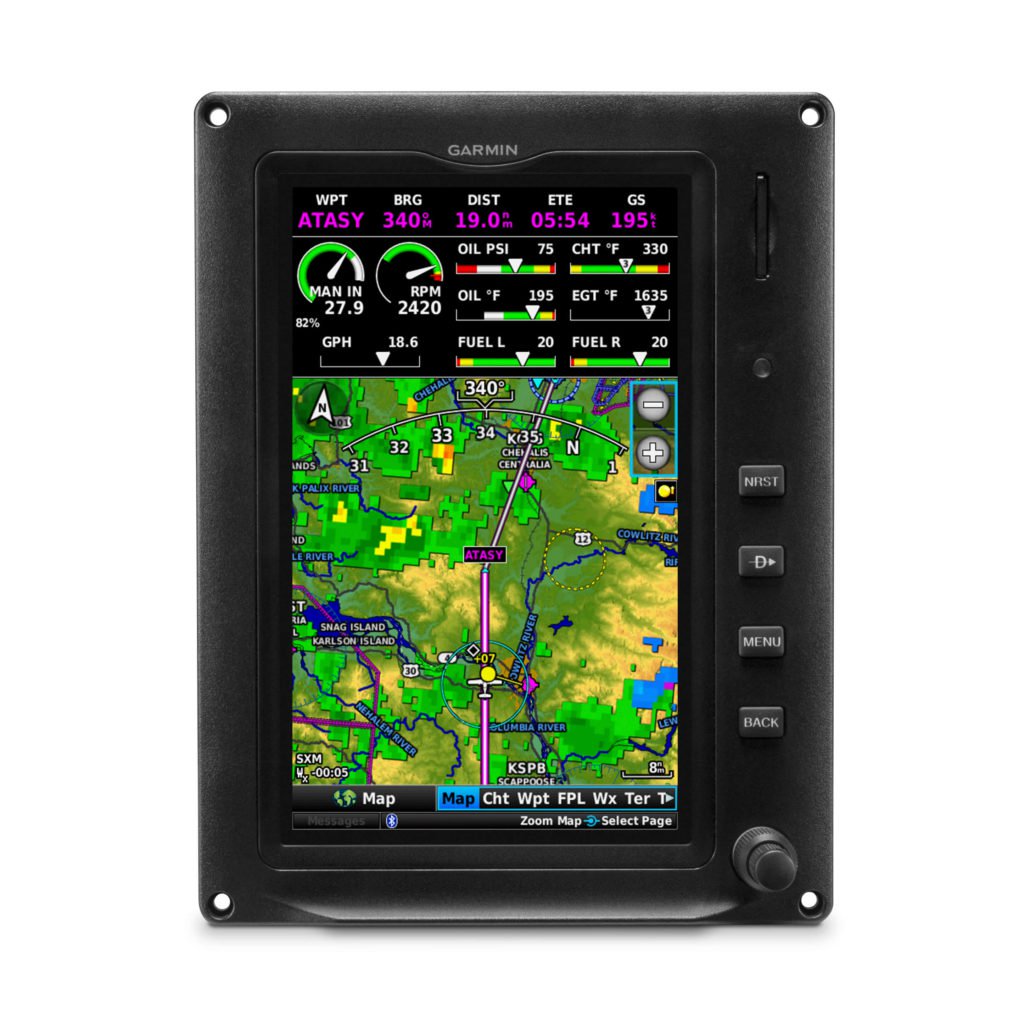
New software and optional hardware for the G5 electronic flight instrument for all customers and G3X Touch for experimental aircraft is expected to be available in August. A comprehensive bundle that enables the display of OAT, TAS, winds and more on the G5 will also be available in August for a list price of $495. The G3X Touch and G5 electronic flight instrument are supported by our award- winning aviation support team, which provides 24/7 worldwide technical and warranty support. We will be showcasing these new features and configuration options next week at the Garmin exhibit during the 2019 EAA AirVenture fly-in, in Oshkosh, Wis., July 22-28, 2019. For additional information, visit www.garmin.com/aviation.
The post TeamX Brings New Features to G5 Electronic Flight Instrument and G3X Touch Flight Display appeared first on Garmin Blog.
https://www.garmin.com/en-US/blog/aviation/teamx-brings-new-features-to-g5-electronic-flight-instrument-and-g3x-touch-flight-display/
GNC 355: GPS/Comm Radio with LPV Approaches
We’re excited to introducing the GNC 355 – a GPS navigator with Localizer Performance with Vertical (LPV) approach guidance, complete with a built-in Comm radio. With the new GNC 355, pilots can take advantage of the benefits of WAAS/SBAS GPS guidance, while also incorporating a modern Comm radio into their existing avionics stack. Intended for Class I/II aircraft that weigh 6,000 lbs./2,721 kg. or less, as well as experimental/amateur-built (EAB) aircraft, the GNC 355 Supplemental Type Certification (STC) is imminent and will be available in August from Garmin Authorized Dealers for over 700 aircraft makes/models.
“Based on the popularity of legacy products like the GX 60 and the GNC 250/300XL, as well as customer
excitement for our new GPS 175 and GNX 375, we’re pleased to bring the GNC 355 to market,” said Carl
Wolf, Garmin vice president of aviation sales and marketing. “The GNC 355 gives value-minded
customers a simple upgrade path to a GPS navigator with a number of capabilities including WAAS/LPV
approach guidance, wireless connectivity, a modern Comm radio, and with its standard mark-width form
factor, pilots can easily add the GNC 355 without overhauling the panel of their aircraft.”
Aircraft owners can easily incorporate the GNC 355 into an existing avionics stack because of its standard
6.25-inch wide by 2-inch tall design. A vibrant, colorful and responsive touchscreen display boasts a
familiar Garmin user experience, while a dual concentric knob and home button offer added versatility
when interfacing with the touchscreen. The user interface has been optimized for the screen size of the
display, while also retaining a familiar menu structure similar to other Garmin products. Pilots can quickly
access direct-to functionality, moving map, flight plan, nearest, procedures, waypoint and terrain pages,
as well as frequency information using the touchscreen, and create customizable data fields and short
cuts for quick, one-touch access to important information.
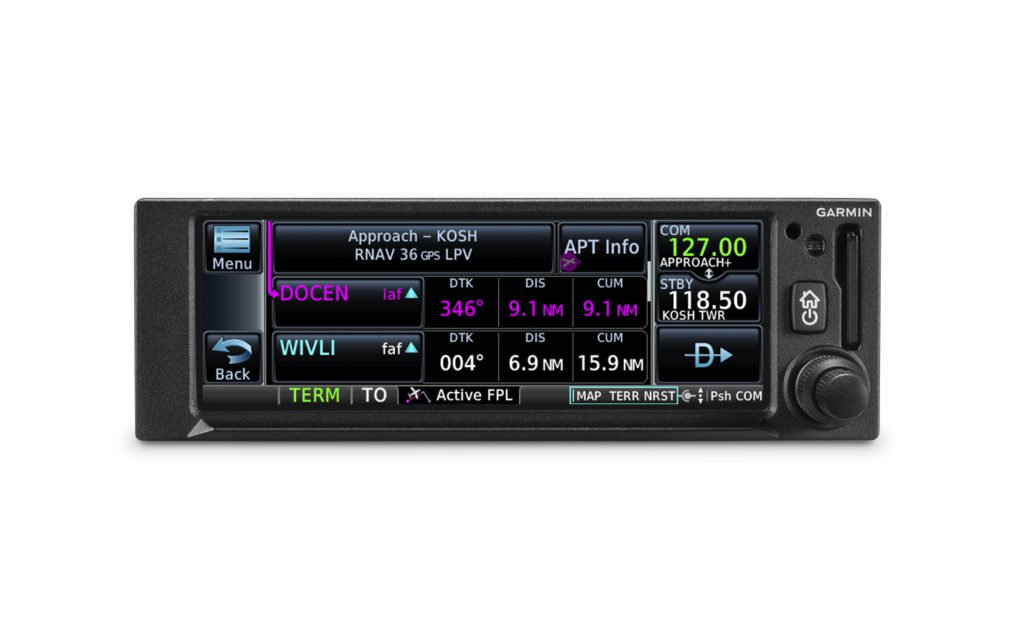
Fully WAAS/SBAS IFR-approach-capable, the GNC 355 gives pilots the benefit of flying LPV, as well as
Area Navigation (RNAV) approaches. Many approaches offer vertical approach guidance as low as 200-
feet above ground level (AGL). Pilots can also leverage the touchscreen and moving map to generate
customized holding patterns over an existing fix in the navigation database or over a user-defined
waypoint and easily insert it into a flight plan. Visual approaches are also available within the GNC 355
and provide lateral and vertical approach guidance in visual flight conditions.
Two versions, the GNC 355 and GNC 355A, are available with 25 kHz and 8.33 kHz frequency channel
spacing respectively. Using the internal frequency database, airport, weather, Air Route Traffic Control
Center (ARTCC) and Flight Service Station (FSS) frequencies are easy to find and can be loaded to the
standby position by selecting the frequency from the airport information page. Recent, nearby and saved
frequencies also offer easy access to frequency information. For example, with built-in standby frequency
monitoring, pilots can listen to ATIS while monitoring tower frequency simultaneously. The airport
identifier and frequency type are also displayed below the frequency so pilots can communicate with
confidence.
An array of interface options include the G3X Touch flight display for experimental and certificated aircraft, the G5 electronic flight instrument, the GFC 500 and GFC 600 autopilots, as well as select third-party autopilots. Course deviation and roll steering outputs can also be coupled to the GFC 500/GFC 600 autopilots and select third-party autopilots so procedures such as holds, radius-to-fix (RF) legs and missed approaches may be flown using the autopilot. Aircraft owners can also retain many of their existing flight instruments, audio panels and many legacy CDI/EHSI indicators such as the KI 208/209 products.
Additional interface options include pairing the GNC 355 with a dual-link Garmin Automatic Dependent Surveillance-Broadcast (ADS-B) solution, such as the GTX 345 or GDL® 88. When paired with these products, the GNC 355 is capable of displaying subscription-free Flight Information Service-Broadcast (FIS-B) weather and ADS-B traffic targets, which includes patented TargetTrendTM and TerminalTrafficTM. Wireless Connext® cockpit connectivity offers flight plan transfer via Bluetooth® to and from compatible portables and mobile devices running the Garmin PilotTM and FltPlan Go applications. Pilots can also use the Flight Stream 510 to access the wireless benefits of Garmin’s Database Concierge, which uploads aviation database information from the Garmin Pilot app to the GNC 355 in minutes.
The GNC 355 provides a number of additional benefits, including graphical flight plan editing, allowing
pilots to more easily edit their flight plan based on an ATC amendment or weather. Features such as
FastFind simplifies flight plan entry by applying predictive logic to suggest airports and waypoints using
current GPS location, while Smart AirspaceTM makes it easier to identify pertinent airspace on the moving
map. The addition of SafeTaxi® airport diagrams display runways, taxiways, Fixed Based Operators
(FBOs), hangars and more relative to the aircraft’s location on the airport surface.
The GNC 355 and GNC 355A are expected to be available in August and will be approved for installation in over 700 Class I/II piston aircraft models that weigh 6,000 lbs./2,721 kg. or less. The GNC 355 and GNC 355A can purchased through the Garmin Authorized Dealer network at that time starting at a list price of $6,995 and $7,695 respectively. European Union Aviation Safety Agency (EASA) validation is expected at a later date. A free GNC 355 trainer app is also available for download on Apple mobile devices, which allows customers to explore the feature set. We will also be showcasing the GNC 355 next week at the Garmin exhibit during the 2019 EAA AirVenture fly-in, in Oshkosh, Wis., July 22-28, 2019. The GNC 355 is supported by our award-winning aviation support team, which provides 24/7 worldwide technical and warranty support. For additional information, visit www.garmin.com/generalaviation.
The post GNC 355: GPS/Comm Radio with LPV Approaches appeared first on Garmin Blog.
https://www.garmin.com/en-US/blog/aviation/gnc-355-gps-comm-radio-with-lpv-approaches/
GSB 15: New, Powerful USB Charger for Aircraft
We are excited to announce the GSB 15, a small, lightweight USB charger designed for a wide range of aircraft. A single GSB 15 contains two USB ports and supports simultaneous 18W (up to 3A) high-speed charging. The GSB 15 has received Federal Aviation Administration (FAA) certification, as well as European approval, and is expected to be available through Garmin Authorized Dealers next week at EAA AirVenture.
“Tablets and mobile devices have become a mainstay in the cockpit and it’s essential to ensure they’re
powered and available throughout an entire flight,” said Carl Wolf, Garmin vice president of aviation sales
and marketing. “The GSB 15 is the smallest installed dual-port USB charger ever designed for aircraft use
that allows owners and operators to easily and economically add USB power capability to their aircraft.”

Designed specifically for aircraft installations, the GSB 15 includes two powerful 18W (up to 3A) USB
Type-A charging ports that allow pilots and passengers to charge tablets and mobile devices in the
cockpit and throughout the cabin in the aircraft. A single GSB 15 is capable of charging two full-size
tablets while using them at full backlight. Optional halo lighting around the exterior of the ports allows
pilots and passengers to connect to the GSB 15 easily during nighttime conditions.
Two versions of the GSB 15 are available and allow for easy installation in space-constrained areas. One
version contains a connector on the back of the unit, which is perfect for panel mount installations. A
second variant has a connector on the bottom of the GSB 15 and is ideal for installations in depth-
constrained areas, such as near cabin sidewalls. Installation is simplified as the GSB 15 can take the place
of an existing aircraft instrument hole with an optional adapter plate. A slim, lightweight design makes it
suitable for installation in any cockpit.
The GSB 15 has received FAA certification, as well as European approval and is expected to begin shipping next week. Customers can purchase the GSB 15 through Garmin Authorized Dealers next week for a list price of $349 USD. we will also be featuring the GSB 15 next week at our exhibit during the 2019 EAA AirVenture fly-in, in Oshkosh, Wis., July 22-28, 2019. For additional information, visit www.garmin.com/aviation.
The post GSB 15: New, Powerful USB Charger for Aircraft appeared first on Garmin Blog.
https://www.garmin.com/en-US/blog/aviation/gsb-15-new-powerful-usb-charger-for-aircraft/
Retrofit G1000 NXi Availability Expanded
We are excited to announce the addition of five aircraft eligible for G1000 NXi integrated flight deck upgrade. These aircraft currently equipped with a WAAS G1000 integrated flight deck include the Cessna 172/182/206 and Beechcraft Bonanza and Baron. The G1000 NXi includes a wealth of features and capabilities such as wireless connectivity, SurfaceWatch, map overlay within the HSI and more. Aircraft owners and operators can easily upgrade from the G1000 to the modern, state-of-the-art G1000 NXi with minimal aircraft downtime and installation.
“Based on the success of the G1000 NXi upgrade programs that are
available today, we’re excited to deliver this upgrade to thousands of additional
aircraft owners and operators,” said Carl Wolf, vice president of aviation
sales and marketing. “With the G1000 NXi, customers experience faster
performance and find tremendous value in new features like wireless cockpit connectivity,
visual approach guidance, SurfaceWatch, map HSI and more, all of which make
this upgrade an absolute must-have in every aircraft.”
Aircraft that currently have a WAAS G1000 integrated flight deck that
are now eligible for the G1000 NXi upgrade are as follows:
- Cessna 172 R/S
- Cessna 182T
- Cessna 206H
- Beechcraft Bonanza
G36 - Beechcraft Baron G58
As part of the G1000 NXi upgrade for these aircraft, Flight Stream 510 and Connext technology enables Database Concierge, the wireless transfer of aviation databases from the Garmin Pilot app on a mobile device to the G1000 NXi integrated flight deck. Additional features enabled by the Flight Stream 510 include two-way flight plan transfer, the sharing of traffic, weather1, GPS information, back-up attitude information and more, among the G1000 NXi and the Garmin Pilot, FltPlan Go and ForeFlight Mobile applications. The G1000 NXi also includes geographical map overlay within the horizontal situation indicator (HSI), visual approach guidance and more.
The G1000 NXi supports the display of various Automatic
Dependent Surveillance-Broadcast (ADS-B) In benefits, including traffic and
subscription-free Flight Information Service-Broadcast (FIS-B) weather1. Other standard features include SurfaceWatch
runway monitoring technology, which provides visual and aural cues to help
prevent pilots from taking off or landing on a taxiway, on a runway that is too
short, or on the wrong runway based on performance data entered during
preflight. Visual and audible runway distance remaining annunciations are also
available via SurfaceWatch. Additional features that are available as standard
include animated NEXRAD weather radar imagery1, Vertical Situation
Display (VSD), IFR enroute charts, VFR sectionals and Visual Reporting Points
(VRPs).
Modernized displays offer improved
readability, while state-of-the-art dual-core processors provide smoother
panning throughout the displays and faster map rendering. Because the flight
displays initialize in seconds, pilots have immediate access to frequencies, flight
plan data and more, saving valuable time in the cockpit. The G1000 NXi
integrated flight deck also incorporates contemporary animations and new LED
back-lighting, offering increased display brightness and clarity, reduced power
consumption and improved dimming performance.
Aircraft owners and operators can easily upgrade to the G1000 NXi with little aircraft down time and disruption of the panel because the displays preserve the same footprint and connectors, so panel and wiring modifications are minimized. Garmin is currently taking orders for the G1000 NXi upgrade in the Cessna 172/182/206, Beechcraft Bonanza and Baron and expects deliveries to begin in July. The G1000 NXi upgrade for these aircraft is available for a list price of $28,995 from Garmin Authorized Dealers (installation and hardware charges may apply), which includes the avionics system software and STC Letter of Authorization (LOA) from Textron Aviation for list price of $4,000. The upgraded components of the G1000 NXi also come with a two-year warranty, which is supported by our award-winning aviation support team. For additional information regarding the G1000 NXi upgrade, visit: www.garmin.com/aviation or contact a Garmin Authorized Dealer.
1.Compatible
datalink required.
The post Retrofit G1000 NXi Availability Expanded appeared first on Garmin Blog.
https://www.garmin.com/en-US/blog/aviation/retrofit-g1000-nxi-availability-expanded/
EAA AirVenture Oshkosh 2019: New Avionics and Showcase Aircraft
The 50th edition of EAA AirVenture at Oshkosh — one of the world’s greatest aviation celebrations — opens its gates to aircraft owners, pilots and fans July 22-July 28, 2019. During that week, airplanes and enthusiasts will converge to create the busiest airspace in the world. This year we’ll be highlighting many of our popular general aviation avionics — tailor-made products for every experimental homebuilder to business traveler.
Display Aircraft — “Draco,” Cessnas, Beechcraft and more!
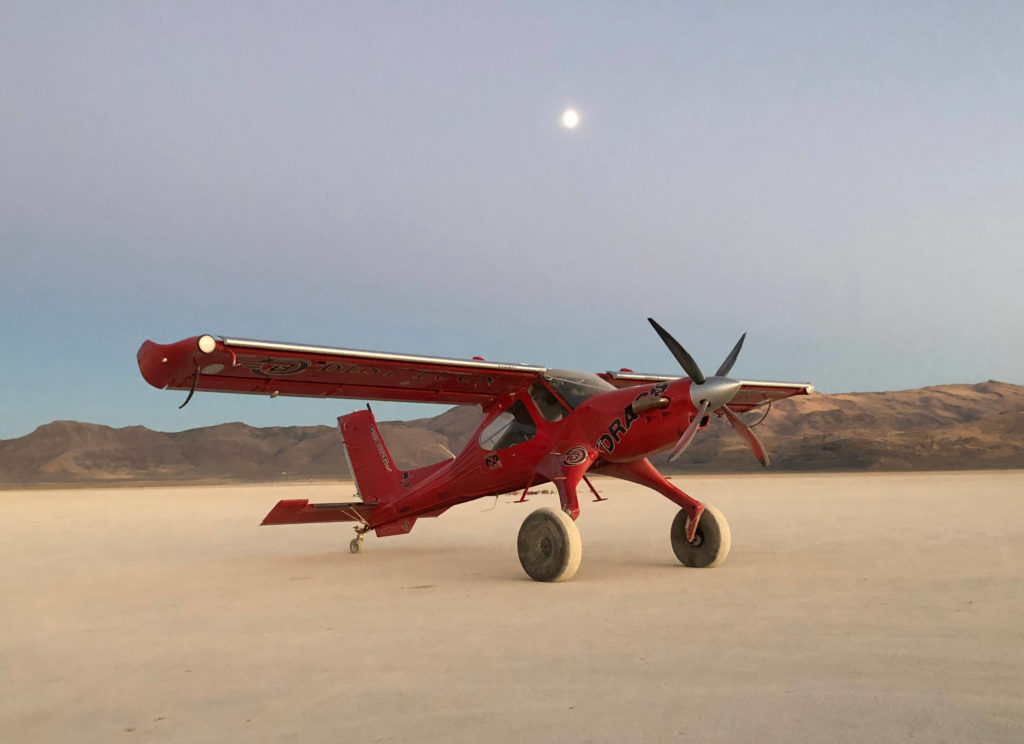
We’ll be hosting a mix of certificated and experimental aircraft at our display just west of Boeing Plaza. Mike Patey and his experimental Wilga, known as “Draco,” will be at our exhibit—this STOL record-breaking, highly modified aircraft features TeamX’s G3X Touch avionics for experimentals. We’ll also be showcasing a Cessna 182 and Beechcraft A36 Bonanza equipped with G500 TXi and GTN 650/750 series avionics. Additionally, another Cessna 182 will be on hand equipped with our new G3X Touch for certificated aircraft. See these aircraft and instrument panels up close, and even talk with a few of their owners and builders at our booth.
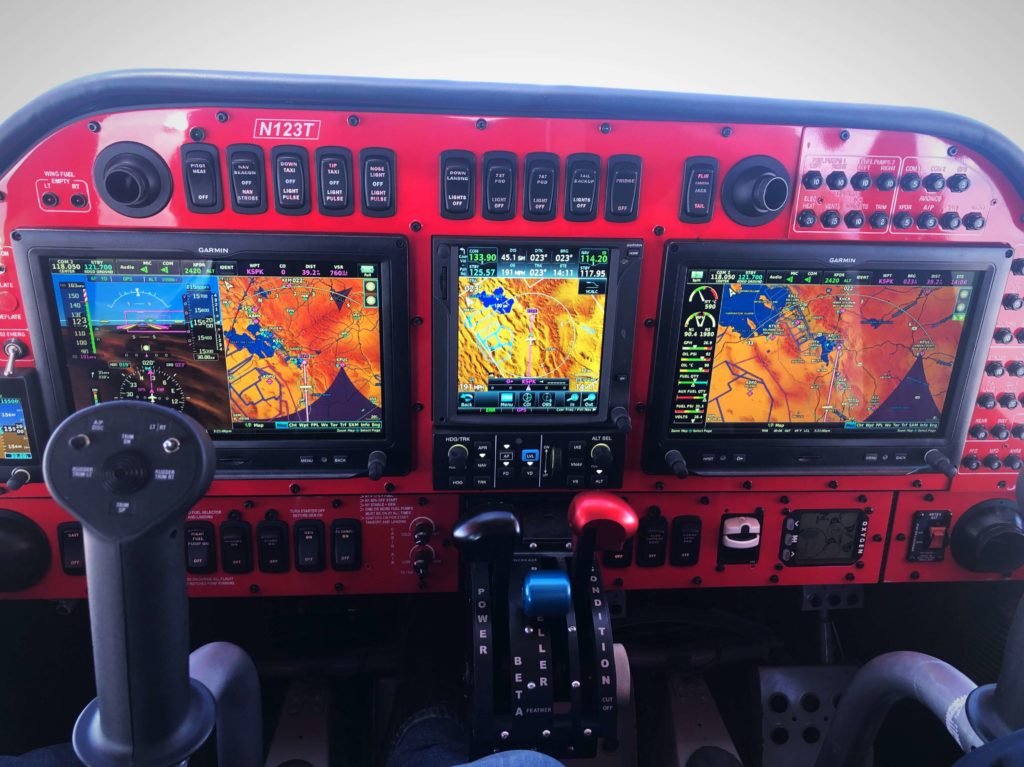
Advanced Avionics
The ADS-B deadline is less than six months away. The closer we get to Dec. 31, 2019, the busier avionics installers will inevitably become. Our low-cost, easy-to-install GDL 82 ADS-B datalink allows you to keep your existing Mode A/C transponder. Wanting to upgrade your transponder altogether? Our GTX 335 provides simple ADS-B “Out” compliance in a transponder upgrade. The next step in our ADS-B line is the GTX 345 — an all-in-one ADS-B transponder featuring ADS-B “In” and “Out” for enhanced weather and traffic information in the cockpit. And our new GNX 375 combines an ADS-B “In” and “Out” transponder with LPV approach capability in a GPS navigator, providing more awareness and capability for an aircraft. It’s a great direct replacement for GPS 150/155, GX 50/55, as well as the KLN 89/90/94 series.
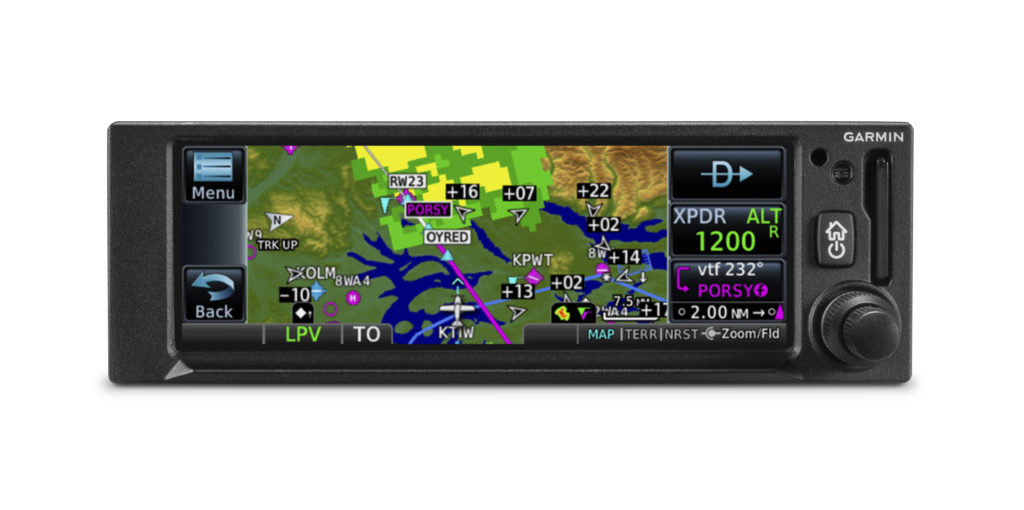
Earlier this year, our TeamX experimental avionics group
introduced its G3X Touch flight display to the certificated market. What had
been a mainstay within the experimental community is now available for more
than 500 certificated aircraft models.
Our new cost-effective solutions for both experimental and
certificated aircraft, including our two new cost-effective GPS navigators: GPS
175 and GNX 375 (with ADS-B “In” and “Out” transponder), give owners an
affordable route to LPV approach capability for their aircraft.
Also be sure to check out our G500/G600 TXi series touchscreen flight displays. See how these advanced avionics offer powerful PFD, MFD and EIS solutions for a number of aircraft platforms.
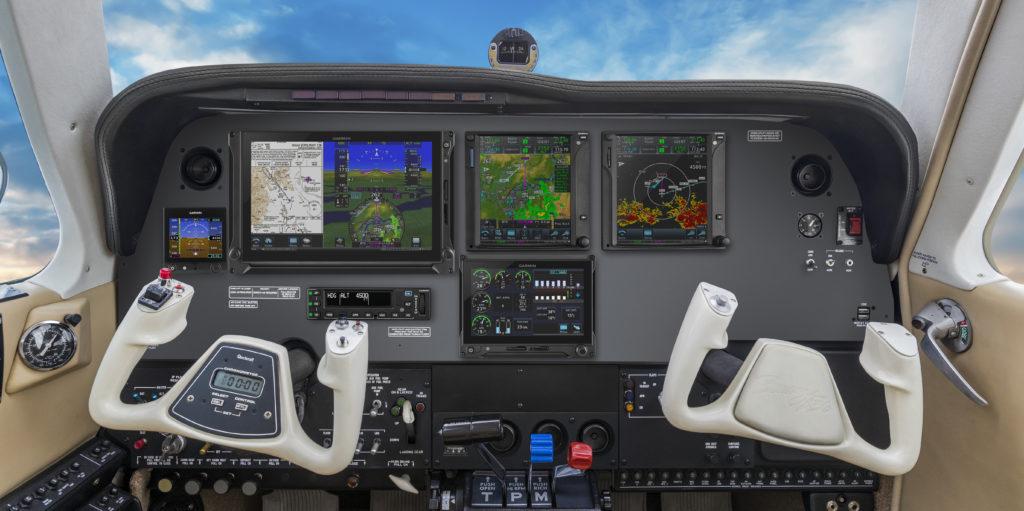
On-site Seminars and Pilot Training
Visitors can attend daily seminars at the exhibit that highlight our range of avionics, from how-to product demonstrations to determining which of our solutions are the best fit for your aircraft. Plus, our award-winning pilot training team will be on site at the Hilton Garden Inn on the Oshkosh airfield, providing real world, hands-on, scenario-based training for the Garmin GTN 750/650 series navigators. These one-day courses (Monday, July 22 through Friday, July 26) are designed to explain the ins and outs of flight planning and instrument procedures. Each participant will be provided with their own kiosk housing real Garmin avionics, a training syllabus for in-class and at-home use, as well as a lunch overlooking the airfield from the hotel patio. Cost for this training is $99 and seats are limited, so register today to reserve your spot! Click here to sign up.
Full seminar schedule:
| Tent 1 | Time |
| G3X Touch TeamX Academy: How to Install G3X Touch Monday and Thursday: System Introduction Tuesday and Friday: CAN Bus Design Wednesday and Saturday: Autopilot Config & Checkout |
8 a.m. |
| G3X Touch TeamX Academy: How to Install G3X Touch Monday and Thursday: Wiring Tips & Tricks Tuesday and Friday: Databases, Software & Configuration Wednesday and Saturday: GPS Navigation Interfaces |
9 a.m. |
| G3X Touch TeamX Academy: How to Fly G3X Touch Monday and Thursday: Intro to G3X Touch Tuesday and Friday: G3X Touch Autopilot Wednesday and Saturday: IFR with G3X Touch & Touchscreen Navigators |
10 a.m. |
| Low-cost Upgrades for Certificated Aircraft: G3X Touch, GPS 175/GNX 375, G5, GFC 500, GTX 335, GMA 345 and more | 11 a.m. |
| Cost-effective ADS-B Solutions: GNX 375, GTX 345/GTX, 335 series, GDL 82 and more | 12:30 p.m. |
| Low-cost Upgrades for Certificated Aircraft: G3X Touch, GPS 175/GNX 375, G5, GFC 500, GTX 335, GMA 345 and more | 1:30 p.m. |
| Tent 2 | Time |
| Real-world Flying with Garmin Avionics: GTN 750/650 series and GPS 175/GNX 375 as well as GFC 500/600 Monday, Wednesday and Friday: Approaches with Touch Screen Navigators & Autopilots Tuesday, Thursday and Saturday: GTN Series VNAV & Autopilot |
8 a.m. |
| Cost-effective ADS-B Solutions: GNX 375, GTX 345/GTX 335 series, GDL 82 and more | 9:30 a.m. |
| Flying with iPad Tablets: Getting Started with Garmin Pilot | 10:30 a.m. |
| Flying with iPad Tablets: Pro Garmin Pilot Tips & Tricks | 11:30 a.m. |
| Upgrading Avionics: GTN 750/650 series, G600 TXi/G500 TXi/EI TXi and GFC 600/GFC 500 | 12:30 p.m. |
| Avionics for Experimental Aircraft: G5 to G3X Touch | 2 p.m. |
The Garmin exhibit will be located just west of the Boeing Plaza. Be sure to follow us on social media throughout the show and tag your photos at our handle—@GarminAviation and #flyGarmin!
The post EAA AirVenture Oshkosh 2019: New Avionics and Showcase Aircraft appeared first on Garmin Blog.
https://www.garmin.com/en-US/blog/aviation/eaa-airventure-oshkosh-2019-new-avionics-and-showcase-aircraft/
G5000 Integrated Flight Deck for Citation Excel/XLS Now Certified
The G5000 integrated flight deck for Textron Aviation’s Citation Excel and Citation XLS has achieved is now certified. The G5000 integrated avionics suite modernizes the cockpit, significantly reduces operational costs, addresses airspace modernization requirements, and solves long-term concerns related to parts obsolescence.
“With close to 50 customer commitments, the market has proven that the ever-popular Citation Excel/XLS
is a perfect platform for the G5000,” said Carl Wolf, Garmin vice president of aviation sales and
marketing. “Based on the tremendous success of our integrated flight deck retrofits, as well as the
reception of our early adopter programs, Citation Excel/XLS owners and operators are excited to start
flying behind the G5000 as it offers an unprecedented level of situational awareness, yields a significantly
lower cost of operation and delivers an exceptional in-flight experience.”
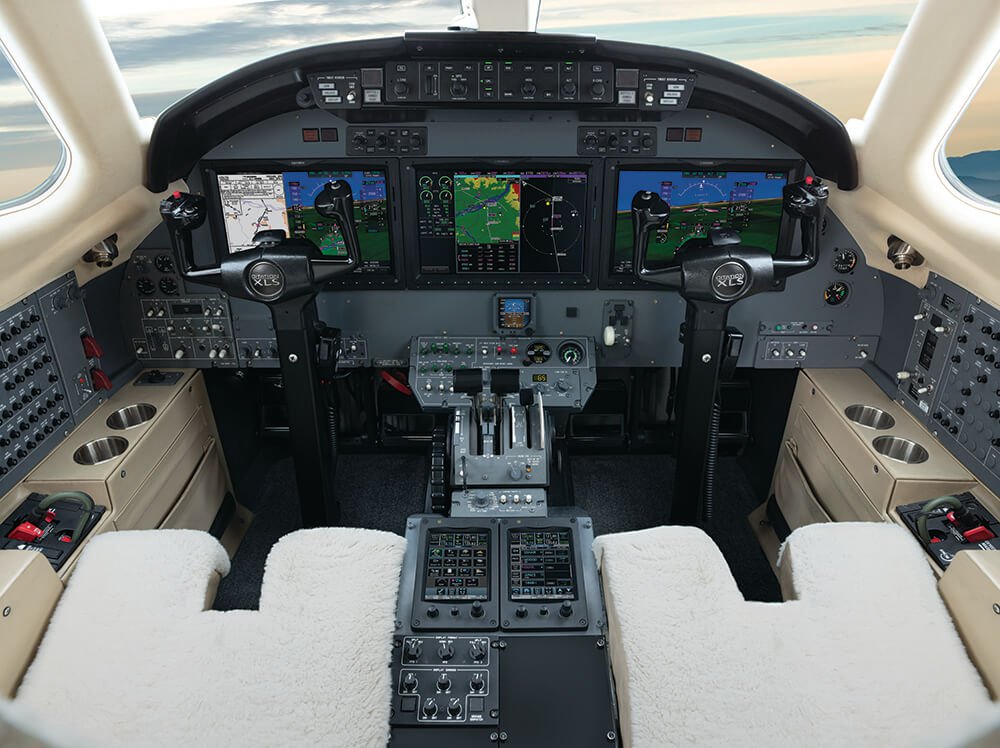
The G5000 integrated flight deck for the Citation Excel and Citation XLS features three landscape- oriented flight displays with split-screen capability, allowing pilots to simultaneously view maps, charts, checklists, TAWS, TCAS, flight plan information, weather and more. Electronic charts and Garmin SafeTaxi airport diagrams are geo-referenced and can be viewed across all three displays. Intuitive touchscreen controllers serve as the pilot interface to the flight deck and contribute to the ease of operation and seamless transition between various pages.
It also includes a fully digital Automatic Flight Control System (AFCS), offering precise performance throughout the aircraft’s flight envelope. New to the Citation Excel, Emergency Descent Mode (EDM) is available as a standard feature with the G5000 and is enabled by the autopilot in the event of a loss in aircraft pressurization. Safety enhancing underspeed protection (USP) is an optional feature that allows the autopilot to assist with airspeed management, while also enabling fully coupled go-arounds, greatly reducing pilot workload.
Additionally, with this upgrade comes a fully integrated, Federal Aviation Administration (FAA) and European Aviation Safety Agency (EASA) rule-compliant Automatic Dependent Surveillance- Broadcast (ADS-B) Out solution. Additionally, operators gain access to more airports and lower approach minimums throughout the world as the G5000 has PBN/RNP 0.3 with LPV/APV approach capability.
With the G5000, pilots can receive departure clearances faster using FAA Data Comm. Controller Pilot
Data Link Communication-Departure Clearance (CPDLC-DCL) automates Clearance Delivery operations at
over 60 of the busiest airports in the U.S. and enables wireless receipt and automatic loading of the
departure clearance into the G5000. Additionally, the G5000 supports En Route CPDLC capability, which
allows the exchange of data link messages with Air Route Traffic Control Centers (ARTCCs) in the U.S.
This capability is expected to be available at all ARTCCs by the end of the year. European operators can
also meet Link 2000+ requirements using this same technology. FAA Data Comm and Link 2000+ require
optional equipment and services.
The G5000 for the Citation Excel/XLS also supports additional options, such as:
- SVT synthetic vision technology, which presents a 3D virtual depiction of terrain, obstacles, traffic and the runway environment.
- SurfaceWatch, which supports visual and aural cues to help prevent pilots from taking off and landing on a taxiway, on a runway that is too short or on the wrong runway based on performance data entered during preflight.
- Datalink weather, including access to global weather products and text/voice communication through the Iridium satellite network.
- Advanced Doppler weather radar features including ground clutter suppression and turbulence detection.
As an additional option for this upgrade, Connext wireless cockpit connectivity via the Flight Stream 510, enables wireless flight plan transfer and more between compatible mobile devices, including
Garmin Pilot, FltPlan Go and ForeFlight Mobile.Owners and operators can more easily manage flight plans with the Flight Stream 510, while also receiving additional benefits such as the sharing of traffic, weather, GPS and more across multiple mobile devices in the cockpit. Flight Stream 510 also enables Database Concierge, the wireless transfer of aviation databases from the Garmin Pilot app on a mobile device to the G5000.
G5000 eLearning training courses
In conjunction with this certification, Garmin has launched two new eLearning courses that are tailored to the G5000 in the Citation Excel/XLS. These courses review a variety of features, operational considerations and scenarios so pilots can familiarize themselves with the capabilities of the G5000. For additional information, visit www.flyGarmin.com/training.
For more information on G5000 and Garmin Services
The G5000 integrated flight deck upgrade for the Citation Excel and Citation XLS is available immediately from Textron Aviation Service Centers and select Garmin Authorized Dealers. For additional information regarding the G5000 upgrade program for the Citation Excel/XLS, contact Dave Brown at (913) 440-1714 or dave.brown@garmin.com or visit www.garmin.com/businessaviation. For additional information on Garmin Services and how to subscribe, visit: www.fltplan.com/aboutus.
The post G5000 Integrated Flight Deck for Citation Excel/XLS Now Certified appeared first on Garmin Blog.
https://www.garmin.com/en-US/blog/aviation/g5000-integrated-flight-deck-for-citation-excel-xls-now-certified/
Turbine Engine Monitoring and Analysis Announced for G600 TXi and G500 TXi
Our aviation team has expanded the engine monitoring capability on the G600 TXi/G500 TXi and Engine Indication System (EIS) TXi flight displays to now include single-engine turboprop aircraft. Pratt & Whitney PT6A turboprop engine display compatibility is certified for several popular aircraft models, including the Cessna 208/208B, Daher TBM 700/TBM 850 and the Piper PA46-310P/350P JetPROP. Engine information can be viewed on a single 10.6-inch TXi display, which can accommodate primary flight display (PFD) information, a multifunction display (MFD) and a vertical EIS strip, and on the 7-inch portrait display, which serves as a dedicated EIS display. Features of the EIS system for turbine aircraft include engine timers, exceedance recordings, dynamic engine indications, as well as wireless data logging that combine to reduce pilot workload, improve engine efficiency and reduce maintenance costs. Additionally, existing engine sensors can be paired with the TXi displays, saving installation time and cost.
“With EIS TXi, owners and operators have a path to replace maintenance-prone engine instrumentation
by upgrading to a modern, more capable system that gives them additional insight into their aircraft’s
operational performance in real-time,” said Carl Wolf, vice president of aviation sales and marketing.
“Because the engine is a significant investment on every aircraft, we’re excited to provide this powerful
tool that allows pilots to easily identify and review aircraft engine performance data so they can more
efficiently manage the aircraft.”
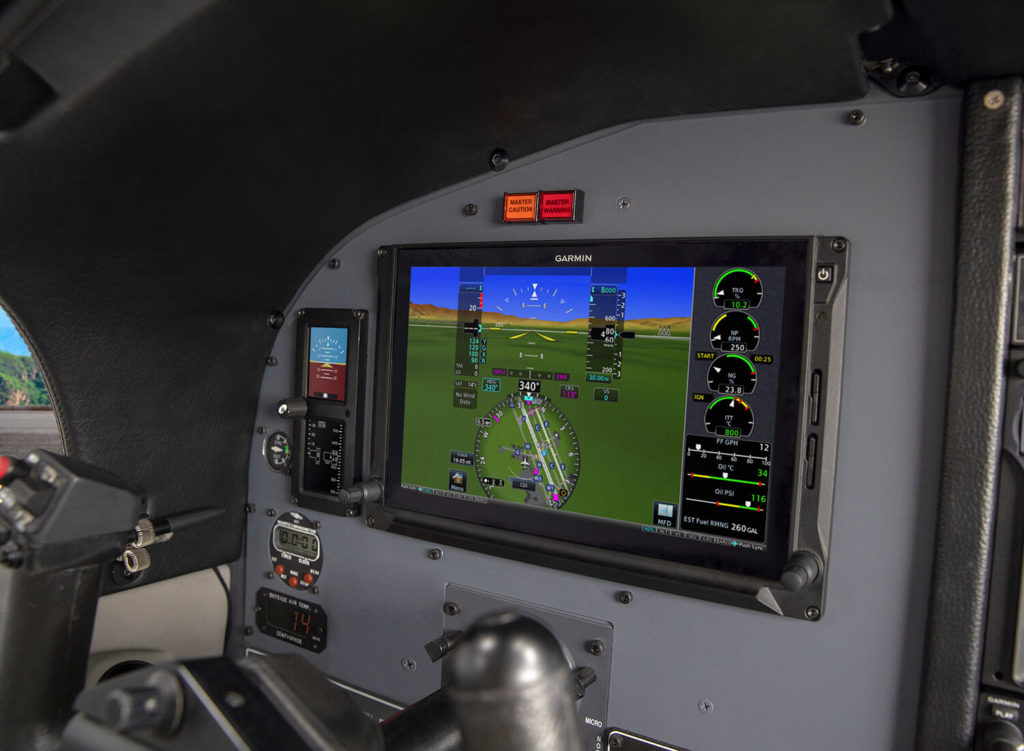
Dynamic gauge limits and indications
All EIS TXi gauge indications display real-time turbine engine information using distinct colors, bands and
radials to clearly label specific limitations so pilots can more easily interpret engine data at-a-glance.
Select turboprop gauges such as engine torque, prop RPM (NP), gas generator RPM (NG), and engine
temperature (ITT) can be configured to change their markings based on pressure altitude, outside air
temperature and more. Dynamic indications are configured during installation so pilots can more easily
operate the engine within its limitations during changing flight conditions. Additional standard gauges
include oil pressure and temperature, as well as fuel flow and electrical system status.
Limit timers and exceedance recordings
Utilizing gauge limit timers, EIS TXi helps pilots maintain the engine within its allowed limits to avoid
engine exceedances and as a result, costly maintenance procedures. For example, once a limit is
reached, a countdown timer is displayed alongside the engine gauge. This timer is an indication to the
pilot that he/she needs to mitigate the exceedance. If the time-based limit is exceeded, the timer and
gauge begin to flash and the pilot receives a notification that an exceedance has been recorded.
Simultaneously, the EIS TXi system automatically logs a variety of information, including the parameter
that was exceeded, duration, highest value that was recorded, time, date and more. The pilot can then
review the exceedance and share it with maintenance professionals for post-flight analysis.
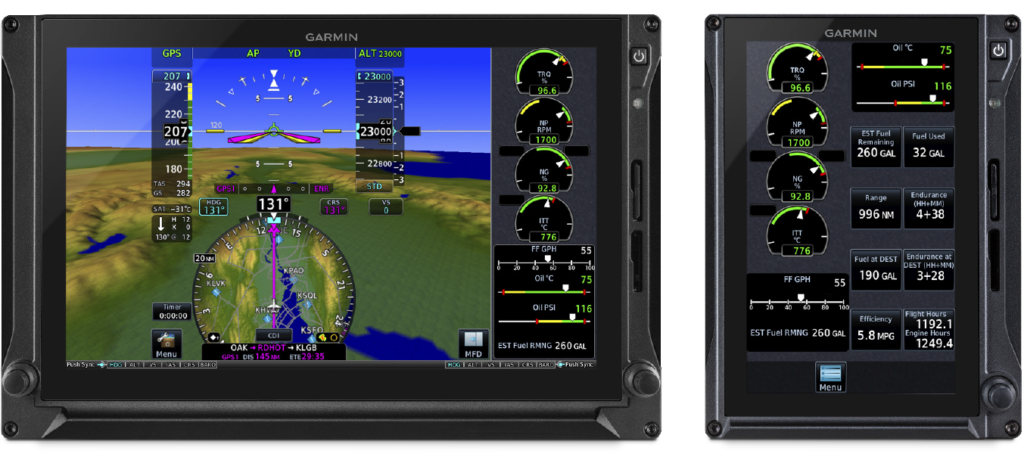
Wireless flight data logging
To assist with tracking maintenance activities, controlling operating costs and analyzing overall engine health, built-in engine data logging is included with EIS TXi. Aircraft performance, engine data and any exceedances that are recorded during a flight are automatically stored on an SD card in the display. When the EIS TXi display or the GTNTM 650/750 navigators are paired with the Flight Stream 510 wireless gateway, information is wirelessly transferred and stored within the Garmin Pilot app and automatically uploaded to the flyGarmin website. Engine and flight cycles are also recorded to help identify aircraft systems that depend on those limits, such as pressurization systems and other life-limited parts.
Add precision to fuel planning
Pilots can more precisely monitor fuel calculations with EIS TXi, which includes an integrated fuel
computer. After making a fuel stop, pilots can enter the fuel data within EIS TXi by selecting “full fuel” or
by adding a specified amount in pounds, gallons, liters or kilograms. When airborne, the system monitors
fuel flow and GPS information to estimate fuel range, endurance and how much fuel is expected to be
available at the destination airport.
The G600 TXi/G500 TXi and standalone EIS TXi are certified for select turbine aircraft, including the Cessna 208/208B, Daher TBM 700/TBM 850 and the Piper PA46-310P/350P JetPROP. Pricing for a standalone EIS TXi flight display starts at a list price of $14,800. The TXi series also comes with a two-year warranty, which is supported by our award-winning aviation support team. For additional information, visit www.garmin.com/TXi or contact a local Garmin authorized dealer.
The post Turbine Engine Monitoring and Analysis Announced for G600 TXi and G500 TXi appeared first on Garmin Blog.
https://www.garmin.com/en-US/blog/aviation/turbine-engine-monitoring-and-analysis-announced-for-g600-txi-and-g500-txi/
COPA Adventure: Navigating Mexico, Central America with Expert Guidance
Within the United States, aircraft owners and pilots benefit from what many consider the best, and easiest, general aviation system in the world. In order to get from point A to point B domestically, it’s relatively simple. Pilots need to submit flight plans and study up on airspace, approach procedures and airport layouts for a given destination. But when it comes to crossing international borders, especially Canada, Mexico, Central America or the Caribbean, there are additional levels of complexity compared to our day-to-day domestic flights in the U.S. Overflight fees, airspace procedures, customs and international handling requirements often vary from country to country, which can be complicated and increase workload and stress on an international flight. Fortunately, our FltPlan.com International Handling services can help make these trips more convenient. Regional aviation experts based in Mexico, Central America and the Caribbean — aircraft operators can utilize helpful guidance, planning and handling services from local professionals. Earlier this year, members of the Cirrus Owners and Pilots Association (COPA) embarked on a fly-out adventure to Mexico and Guatemala and took advantage of FltPlan.com integration with Garmin avionics and local expert guidance from Caribbean Sky Tours.
Destination: Central America
COPA is an organization of more than 5,700 members worldwide
that focuses on education, training and safety programs for the Cirrus aircraft
fleet. In addition to helping keep their aircraft properly maintained and
pilots proficiently trained, they also have regular social gatherings and
fly-outs to help bring their members together. For the third straight year,
members united in their Cirrus SR20s, SR22s and even an SF50 Vision Jet to
explore destinations south of the border. Their adventures range from Mexico
and Costa Rica to as far south as Panama, visiting tourist spots, cultural
landmarks and UNESCO World Heritage sites.
This year’s trip kicked off on March 9, when 11 aircraft
departed their home bases from all over the United States for two jumping-off
points: Brownsville, Texas, and Key West, Florida.
Comprehensive Trip Planning and Preparation
Planning for the trip began long before their departure, with
detailed briefings to prep the pilots on the different international
procedures, airspace requirements and fees, plus customs and handling
instructions for their upcoming destinations. The team also managed the flight
plans, overflight and airspace fees, coordinated all the ground handling in
advance and made hotel accommodations for the visiting crews.
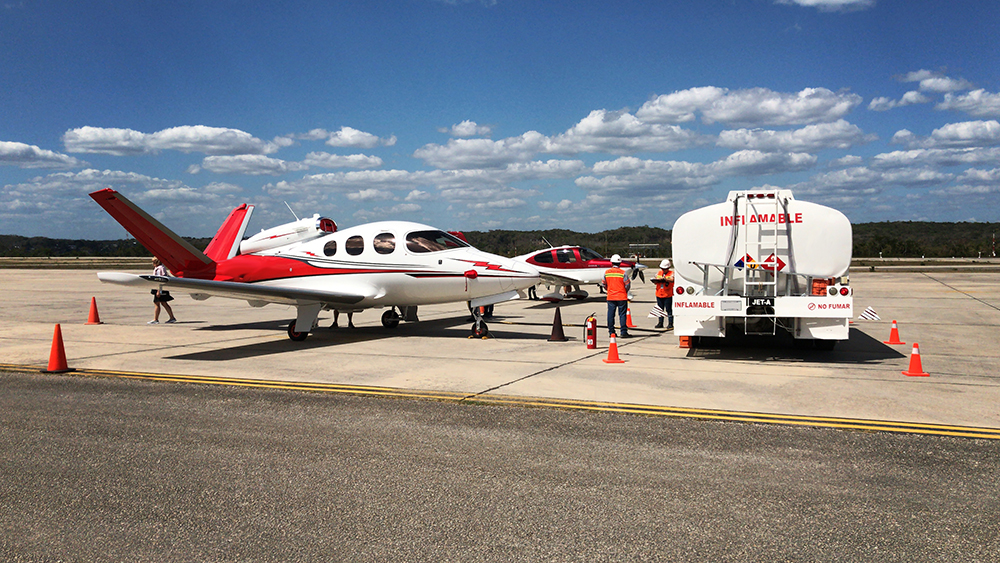
Added Convenience for International Departures and
Arrivals
On March 10, their international flight plans were filed, and the 11 aircraft departed from south Texas and Florida for Veracruz, Mexico. Along the way, each aircraft’s progress was monitored by the Caribbean Sky Tours team by using Garmin inReach satellite communicators.* With the inReach devices, the team was able to not only track the progress of each aircraft, but also have two-way communication in-flight. With preparations already made in advance for each destination, ground handlers were standing by upon landing in Veracruz. From there, the aircraft completed the 850-mile journey to Mundo Maya, Guatemala, where crews spent several days enjoying local food, touring historic ruins and taking in the local culture.
At the end of their Guatemalan stay, pilots were briefed on
the procedures required for the next stage of their journey — Campeche, Mexico.
Upon arrival they were met with preplanned ground handlers, fuel and customs
services. After another extended stay enjoying local cuisine, tourist
destinations and culture, the group was ready to return to the states by way of
Key West and Brownsville.
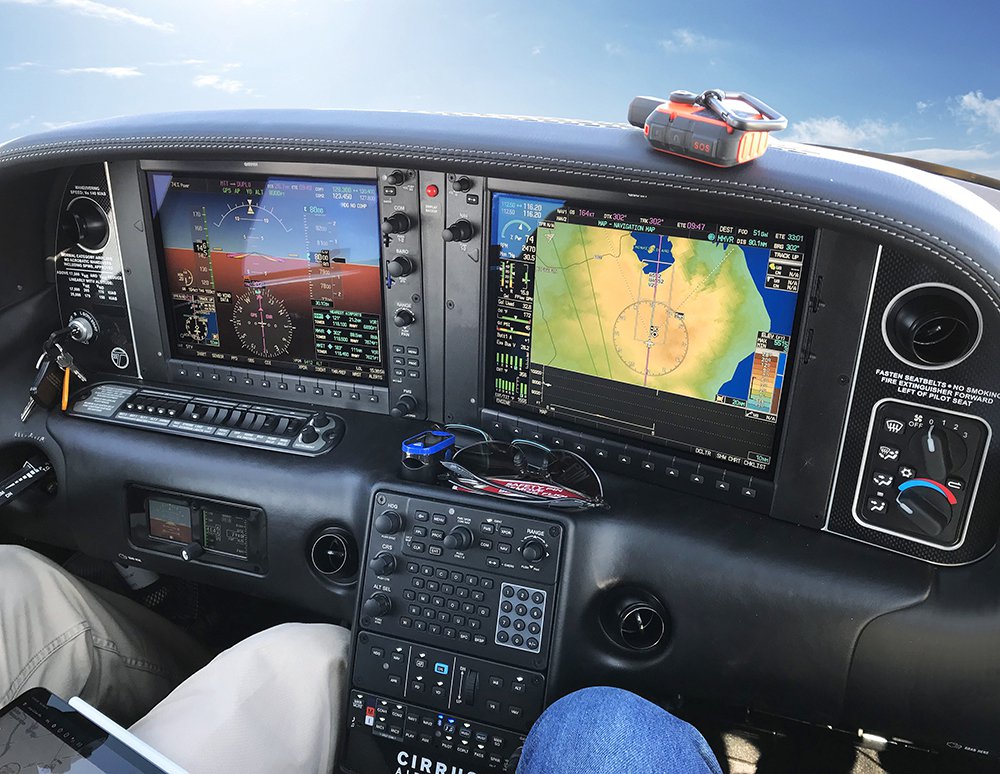
Expert International Guidance from FltPlan.com
Through our FltPlan.com services, aircraft owners and
operators have access to International Handling and Airspace Overflight
expertise. Service begins by signing up for a free account, where web-based
flight planning, certified weather, airport information and more is available
at no cost. When flight plans are filed to international destinations through
FltPlan.com, additional handling services and guidance are available. The team
has specialists based in Mexico, Central America and the Caribbean, ready to
help pilots and crews with every aspect of an international trip — from flight
planning and flight tracking to electronic advanced passenger information
services (eAPIS), ground handling coordination and customs. Add convenience and
peace of mind to any international trip with local expert guidance along the
way, before, during and after.
For more information about our FltPlan.com tools, plus international handling services and expert guidance, visit our website and sign up for an account today.
*Jurisdiction
restrictions may apply.
The post COPA Adventure: Navigating Mexico, Central America with Expert Guidance appeared first on Garmin Blog.
https://www.garmin.com/en-US/blog/aviation/copa-adventure-navigating-mexico-central-america-with-expert-guidance/
New Features for FltPlan.com Safety Management System and FltLogic Scheduling Program
We’ve added several new features within the FltPlan.com Safety Management System (SMS) and FltLogic flight scheduling program. FltPlan.com has partnered with the Air Charter Safety Foundation (ACSF) to enable FltSafety.com SMS subscribers who are ACSF members, to voluntarily file Aviation Safety Action Program (ASAP) reports with the FAA. This integration further facilitates a proactive approach to self-reporting, while also identifying areas within a flight department where operational improvement is needed. Additionally, several new enhancements have been made to the FltLogic flight scheduling program that streamlines the user interface and allow users to see more information at-a-glance.
Flight departments can easily identify, track and mitigate risks using
FltPlan.com’s Safety Management System and ACSF ASAP participants can now
utilize it to submit ASAP reports to the FAA. The FAA’s Aviation Safety Action
Program focuses on the voluntary reporting of issues related to noncompliance
and/or safety. The voluntary nature of this initiative encourages compliance
with FAA regulations, while also fostering safe operating practices and
promoting the development of proper internal evaluation programs that have a
long-term impact on the safety of an operator and their organization.
Pilots can take advantage of the latest version of the Safety
Management System via the FltSafety.com website. Participation in the ASAP
program through FltSafety.com requires advanced registration with the Air
Charter Safety Foundation.
Several new features have also been added to FltLogic, a
comprehensive flight scheduling program that can be utilized within flight
departments starting at the initial trip request phase through post flight analysis.
These new features include:
- A new
single-page edit design allows users to more easily modify trip details. - Users
can create a private event within FltLogic, which hides all trip information
except the tail number of the aircraft. - Pilots
and schedulers can more easily track canceled and completed trips within FltLogic,
which now incorporates a canceled and completed trip box. - An
authorized pilot view gives pilots certain permissions within FltLogic to view
scheduled events for any aircraft the pilot is authorized to fly. - Calendar
colors can now be customized to indicate specific events such as maintenance or
training, so it’s easier to identify aircraft reservation information.
These new features within FltPlan.com and FltLogic are available immediately. For additional information, visit: www.FltPlan.com and www.FltLogic.com.
The post New Features for FltPlan.com Safety Management System and FltLogic Scheduling Program appeared first on Garmin Blog.
https://www.garmin.com/en-US/blog/aviation/new-features-for-fltplan-com-safety-management-system-and-fltlogic-scheduling-program/
